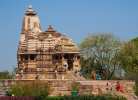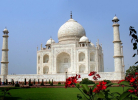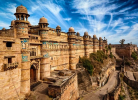About Taj Mahal
Taj Mahal is an epitome of love and romance. Every year, millions of lovebirds and young couples visit Taj Mahal as an expression of their love to each other. As decades and centuries pass by, the value of love that the monument brings out is getting stronger. Today, the number of tourists visiting Taj Mahal every year is twice the population of inmates of Agra.
Taj Mahal is a 17th century marble monument built by Mughal emperor Shah Jahan for wife, who died in his arms while giving birth to their 14th child. Taj Mahal was initially named as Roze-e-Munavvara, which can be literally translated as ‘Unique Building’.
About Taj Mahal Land
Before Taj Mahal was built, the land was a lush orchard belonging to King Jai Singh. Shah Jahan compensated King Jai Singh for the land in exchange for his five havelis. It is said that according to Islamic rules, a mausoleum should not be built on donated land.
Thus, Shah Jahan insisted on the exchange. Taj Mahal was built as per the designs executed by Ustad Abdul Karim and Ustad Ahmad Lahori. The blueprints of Taj Mahal and many correspondences related to it can be seen in the museum inside the monument. Artisans from around the world were employed for a little more than two decades.
In 1983, several centuries after its construction, the monument was tagged as a heritage site. With increase in people visiting Taj Mahal, in the early 1960s, the monument was open 24/7 without any ticket. In a process to control the crowd, today, Taj Mahal is one of the highly ticketed site of Agra and each visitor is given only three hours to stay inside the monument. Only 400 night tickets are sold during the opening nights.
History of Taj Mahal
Shah Jahan became the Emperor of the kingdom in the year of 1628 and entrusted Arjumand Banu with the royal seal. Bewitched by her beauty and intelligence, he also bestowed her with the title of Mumtaz Mahal, meaning the "Jewel of the Palace".
Mumtaz Mahal was his favourite wives among the several others, who accompanied him everywhere, even on military campaigns. Shah Jahan was so taken by Mumtaz that he showed little interest in exercising his polygamous rights with his two other wives, other than dutifully making a child with each. According to Shah Jahan's historian, Inayat Khan assumed that 'his (Shah Jahan’s) whole delight was centred on this illustrious lady (Mumtaz) to such an extent that he did not feel the same towards the others (his other wives) one-thousandth part of the affection that he did for her’.
Who was Mumtaz Mahal?
Mumtaz Mahal shared a loving marriage with Shah Jahan, characterised by a deep bond. Even during her lifetime, poets would caress her beauty, grace, and compassion through their writings. It is believed that with immense beauty, the empress also possessed a high level of intelligence as well and that she was excellent at the game of chess.
Mumtaz maintained a high degree of political power and influence that is evident in plenty of historical documents that confirm her involvement in administrative matters and government orders. She was his constant companion and trusted confidant, leading court historians to go to unheard lengths and manager of Shah Jahan’s court. The amount of affection and trust placed in each other for the carrying out of administrative functions is indeed considered to be a major part of an essential love story.
Mumtaz Mahal was a woman who desired to forever live in harmony with his spouse and a lot of children. Her wish, at that point of time was fulfilled and she was blessed with a healthy marriage of 19 years and bore eight sons and six daughters. Unfortunately, among the fourteen, there were seven of the children who died at birth or at a very young age. In spite of her frequent pregnancies and weak health conditions, Mumtaz travelled with Shah Jahan's throughout his earlier military campaigns and the subsequent rebellion against his father. However, their happiness was short-lived as love stories need to comprise of a twist!
How Many Workers Built The Taj Mahal?
Over 40 thousand workers and more than hundred elephants worked in the site to bring out Shah Jahan’s vision, a marble monument that would stand above everything else, just like his love for his wife.
How Much Money was Spent to Build Taj Mahal?
More than 4000 kg of gold and 39 different types of semi-precious stones were used for the construction of the site.
Which Day Taj Mahal Remains Closed?
Taj Mahal remains closed on Friday and only accessible in the afternoon for Muslims to attend pray
Do you know about Black Taj?
After the construction of the marble white Taj, the idea and construction of a ‘Black Taj’ was also in the making but it was stoped by Shah Jahan’s own son named Aurangazeb who succeeded the throne by force and held his father captive. Due to ill-health and frail administration, Aurangazeb took over the dynasty.
After the construction of the marble white Taj, the idea and construction of a ‘Black Taj’ was also in the making but it was stoped by Shah Jahan’s own son named Aurangazeb who succeeded the throne by force and held his father captive. Due to ill-health and frail administration, Aurangazeb took over the dynasty.
There is a contrast that emerged upon the death of Shah Jahan's that Aurangzeb buried him in a tomb next to his wife in probably the simplest manner whereas Shah Jahan got the body of his beloved Mumtaz in a golden casket from Burhanpur to Agra, carried in a boat by only two men and buried her in the Taj.What are the Threats for Taj Mahal?
It is insisted that it is better to visit Taj Mahal as soon as possible. There are two threats to the existence of Taj Mahal. First is the uncontrolled air pollution in Agra, which is leading to erosion and yellowing of the marbles in Taj Mahal. There are measure carried out to counter-effect the process. The second problem is River Yamuna. When Taj Mahal was built, an ebony base was given to support the weight of the monument. The ebony base was designed to get water supply from River Yamuna to stay wet to be strong. With decline in water level in River Yamuna, the strength of the base of Taj Mahal is becoming a bigger question. So, make sure to visit the monument when you really can.
Conclusion
The design was conceived by Jahan as an earthly replica of the house of Mumtaz Mahal in paradise. He also desired to create it likewise as a symbol of solemnity, harmony, purity and spirituality as well. The thoughts that come into the mind while watching the Taj Mahal of Agra is not just its phenomenal beauty, but the immense love which was the reason behind its construction. The love claims to be eternal and divine and has proven to be so as evidently, people still read the history and relevance of it through text books or internet articles and posts.
The plot of their love story seems to be a pretty dramatic one for an average human being but who could ever think that an eternal love would lead to the saga of infinite bondage. The Taj has left a reminder for all mankind about the universally accepted concept of ‘Love & Peace’ - leaving out the prejudices and discriminations based on race and geographical boundaries - is important to be observed solemnly. The Mahal does not only scream true love and a pure bond but also eternity of a soul connection. People went, but souls stayed.
















